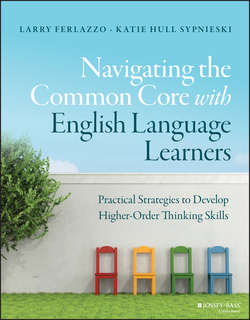Читать книгу Navigating the Common Core with English Language Learners - Sypnieski Katie - Страница 7
На сайте Литреса книга снята с продажи.
Introduction
ОглавлениеThe Common Core Standards, and the standardized tests tied to them, are now being implemented in most states. And the few states that have not adopted them have created their own very similar ones.1
This transition offers school districts, schools, and teachers an opportunity to pause and reflect on their practices and consider how to ensure that students, including English language learners, are developing the skills necessary to thrive in our changing world. Transitions are often breeding grounds for anxiety and fear of the unknown. However, they can also be a doorway leading to growth and new possibilities.
We know many parents, teachers, and students are feeling anxious, especially around the new Common Core assessments. We share those concerns, especially since we think there are more pressing issues facing our schools and students than a need for new Standards, such as the need for increased school funding, family services, institutional commitment to – and advocacy for – ELL students, and time for teacher collaboration, to name just a few. Nevertheless, we live in the world as it is, not as we'd like it to be. Therefore, we are committed to facing change in ways that create the most positive outcomes for our students. Navigating the Common Core with English Language Learners is written in this spirit of adaptation and openness.
We have taken the four years since the publication of our previous book, The ESL/ELL Teacher's Survival Guide,2 to reflect on, and review, our practice in light of the Common Core and apply what we consider to be its positive elements – particularly its emphasis on higher-order thinking – to improve our teaching. Though most of the content in our first book is certainly compatible with the Standards, and we still apply the practices described there in our classrooms, we have also developed new and refined older ones to make them even more effective for our students and more aligned to the new Standards.
Readers will find that at least 90 % of the content in this book is new material not found in our previous one. Even though the word count of this book has strained the outer limits of our publisher's guidelines, it is by no means exhaustive. Each domain – reading writing, speaking/listening, language – and each subject – math, social studies, science – deserves its own book. However, we don't have the time to write them and we know few teachers who would have the time to read them!
You will also find that, though many of the lessons we discuss in these chapters are applicable to Beginning English language learners, more are written with Intermediate and Advanced ELLs in mind.
We believe that teachers of ELLs and non-ELLS alike will find our Social Emotional Learning lessons, our clear analyses of the Standards, and our classroom recommendations helpful.
Our students, their families, and we as educators face some very big challenges ahead. We hope that this book can help make those challenges a little more manageable for all of us.
For downloadable versions of all lesson plans and student hand-outs found in this book, go to the “Downloads” section of this book's web page at www.wiley.com/go/navccss. In addition, you will find two “bonus” book chapters on that page: One is on using Art with English Language Learners while meeting Common Core Standards, and is written by high school English and Art teacher John Doolittle. The second chapter is on how school counselors can assist both English Language Learners and their teachers as they work to meet Common Core Standards. This second chapter is written by Leticia Gallardo, a high school counselor.
1
Felton, E. (2015, May 28). Why are so many states replacing Common Core with carbon copies? The Hechinger Report. Retrieved from http://hechingerreport.org/why-are-so-many-states-replacing-common-core-with-carbon-copies/
2
Ferlazzo, L., & Hull Sypnieski, K. (2012). The ESL/ELL teacher's survival guide: Ready-to-use strategies, tools, and activities for teaching all levels. San Francisco, CA: Jossey-Bass.
